L’Anfiteatro Romano di Spoleto è situato nell’omonima via, vicino a Piazza Garibaldi e al di fuori della prima cinta muraria, nella zona nord della città.
Si tratta di un complesso architettonico e monumentale che copre un’area di 17.000 m², una vera e propria città nella città nella quale sono ancora in corso lavori di scavo e ristrutturazione degli edifici rinvenuti.
Oltre al bellissimo Anfiteatro, il complesso comprende anche tre ampi chiostri, cortili e giardini, degli ex monasteri con chiese annesse. Luoghi antichi e ricco di storia, in cui ammirare i fasti del passato e toccare con mano la vita di epoche così lontane e allo stesso tempo così vicine.
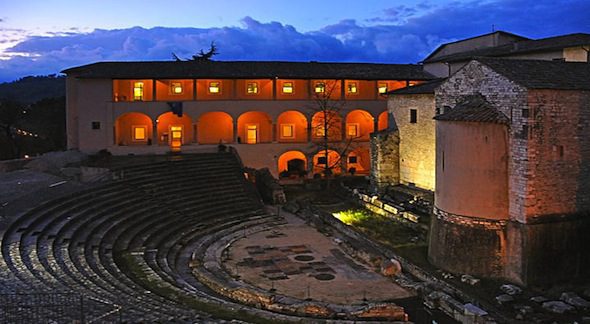
Storia e curiosità del Complesso dell’Anfiteatro romano
Il maestoso Anfiteatro conserva una cavea dal diametro di 70 metri, in parte appoggiata su di un ambulacro semicircolare coperto da volte a botte, dal quale si accedeva ai posti a sedere attraverso tre accessi. Dalle estremità della cavea si accedeva invece ai posti riservati ai magistrati e ai cittadini eminenti. L’orchestra conserva la pavimentazione in lastre di marmo colorato e sul proscenio sono visibili i fori per i pali del sipario. La facciata esterna era costituita da arcate inquadrate da semicolonne di ordine tuscanico.
I resti dell’opera originale ancora visibili sono sufficienti a mostrare che, intorno alla struttura, correva un doppio ordine di arcate sovrapposte, forse con attico, e che la muratura a secco era probabilmente rivestita da un paramento in pietra.
La costruzione dell’edificio è datata I-II secolo d.C. e le sue grandi dimensioni aiutano a darci la misura dell’importanza rivestita all’epoca da Spoletium.
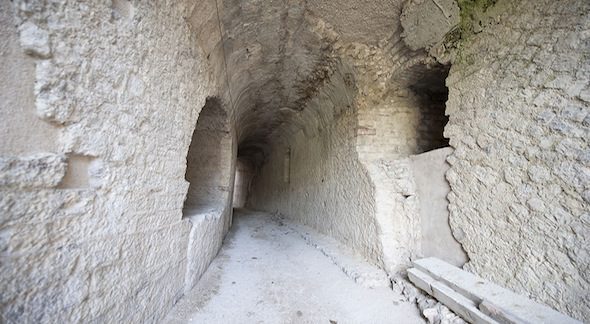
L’anfiteatro venne utilizzato per giochi dei gladiatori e spettacoli circensi; probabilmente, fu destinato anche al martirio pubblico di alcuni santi spoletini che qui vennero fatti divorare dalle belve feroci. Quando Spoleto passò ai longobardi, il re degli Ostrogoti Totila trasformò l’anfiteatro in una fortezza e questa venne impiegata per più di un secolo per usi militari, rimanendo una sorta di blocco isolato e quasi dimenticato rispetto alla città stessa.
Nel periodo medievale divenne un centro di commercio, con le arcate dell’ambulacro che vennero adibite a botteghe e magazzini.
In seguito, l’area divenne una cava di pietre per rispondere al bisogno di materiali utili alla costruzione della Rocca Albornaz, e in scia anche per altri edifici cittadini.
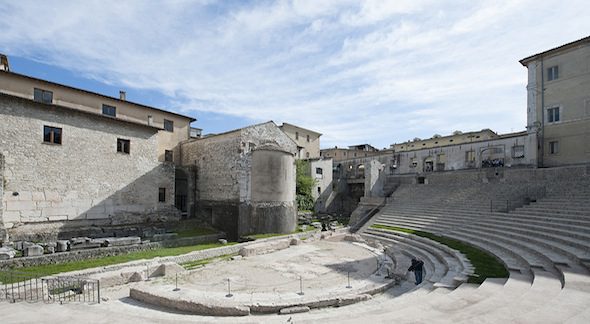
>>Vuoi visitare l’Anfiteatro Romano? Contatta ora i migliori agriturismi di Spoleto e scopri le offerte!
L’anfiteatro tra ieri e oggi
L’anfiteatro di Spoleto rappresenta dunque un caso di continuità di vita di un edificio antico, documentato dalle varie modifiche apportate per adattarlo a nuove e diverse funzioni.
Già nel De Bello Gotico di Procopio viene ricordata la sua trasformazione in fortezza durante l’occupazione dei goti, con la serie di tamponi murari delle arcate. Sopra la cavea, all’inizio del XII secolo fu eretta la chiesa dedicata appunto a San Gregorio Minore, pare forse proprio nel luogo in cui Gregorio subì il martirio. Verso la metà del Duecento, su parte dell’area dell’Anfiteatro fu costruito il Monastero di Santa Maria della Stella: le Monache Agostiniane vi accolsero per due secoli gli infanti abbandonati. Il corpo di fabbrica venne utilizzato da botteghe di commercianti nel XIII secolo d.C. e, infine, subì il progressivo smantellamento per l’edificazione della Rocca Albornoz, che reimpiegò gran parte dei materiali di rivestimento dell’arena.
Tutto l’edificio è in opus caementicium, cioè un nucleo formato da pietrisco frammisto a calce, e rivestito in opus vittata che consiste nella disposizione di blocchetti di calcare tagliati regolari e disposti su filari orizzontali, oggi visibile solo nel muro interno della galleria. Lo studio delle tecniche e delle fasi di lavorazione ha permesso di identificare l’opera come un progetto unitario, datato, grazie soprattutto all’impiego della opera vittata alla fine del I secolo d.C.
Gran parte dell’anfiteatro, come le parti dell’ambulacro e uno degli accessi minori alle gradinate, è oggi inglobata nel settore urbano che costituisce un unico corpo edilizio appartenente alla caserma Severo Minervio.
Attualmente la struttura dell’Anfiteatro Romano ospita concerti, balletti e altre manifestazioni culturali, soprattutto in occasioni importanti come il Festival dei 2 Mondi di Spoleto.
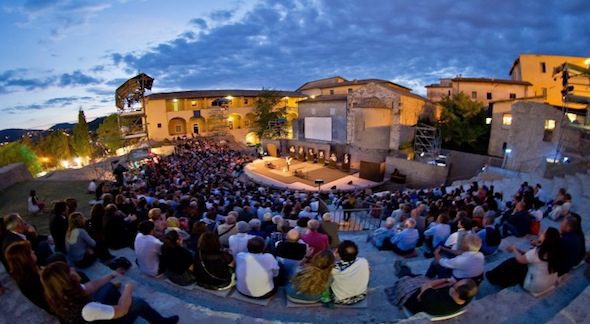
>> Ci sono offerte in scadenza! Clicca e consulta la lista dei migliori hotel nella zona di Spoleto!
Informazioni pratiche per la visita: orari e biglietti
L’Anfiteatro Romano si trova nel centro storico di Spoleto, a poca distanza da tutte le altre attrazioni principali. Per chi arriva in auto e intende visitarlo, il punto più vicino in cui lasciare la propria auto è il parcheggio a pagamento SpoletoSfera3, seguito poi da SpoletoSfera Carducci e SpoletoSfera1.
Orari di visita all’Anfiteatro
Apertura con orario continuato tutti i giorni dalle 08:30 alle 19:30.
Previste chiusure annuali nelle giornate del 01 Gennaio, 01 Maggio e 25 Dicembre.
Biglietto di ingresso all’Anfiteatro
Il biglietto per la visita ha un costo di € 4,00 a persona. Previste riduzioni a € 2,00 per ragazzi tra i 18 e 25 anni, mentre ragazzi e bambini sotto i 17 anni entrano gratuitamente.
La prima domenica di ogni mese l’ingresso è gratuito per tutti.
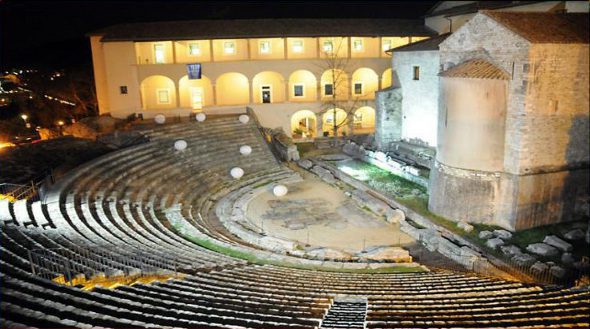
>> Se hai deciso di vedere Spoleto e di visitare l’Anfiteatro Romano ti consigliamo di contattare ora gli agriturismi nelle sue vicinanze
Located in the homonymous street, close to Piazza Garibaldi, the Roman Amphitheatre was a great space for the gladiatorial games. it was built in the early years of the Roman Empire and still retains an auditorium with a diameter of 70 meters in an ambulatory hand resting on a semicircular shape, covered by a barrel vault, from which you could access through three entrances to the seating . From the end of the auditorium was reached instead for the posts reserved for judges and prominent citizens. The orchestra keeps the paving slabs of colored marble, and on the stage you can see the holes for the poles of the curtain. The external facade was made up of arches framed by half-columns of the Tuscan order. The remains of the original work are still visible enough to show that around the structure there was a double row of overlapping arches, perhaps with the attic, and that the drywall was probably covered with a facing stone.
>> Do you want to visit the Roman Amphitheatre? Contact now the best farmhouse in Spoleto and discover their offers!
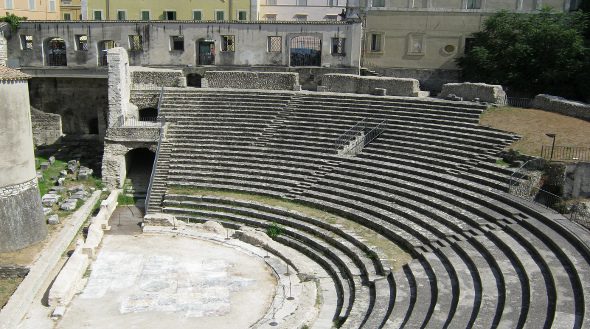
The amphitheater of Spoleto is a case of continuity of the life of an old building, documented by various modifications to adapt it to new and different functions to be progressively dismantled for the construction of the fortress Albornoz, who reuse most of the materials of coating of the arena.
>> There are offers in deadline! Click and consult list of the best hotels in Spoleto!

Much of the amphitheater, like the parts of the ambulatory and one of the entrances to the lower tiers, is now incorporated in the urban sector which constitutes a unique body building belonging to the barracks Severo Minervio.
The structure of the Roman amphitheater now hosts concerts, ballets and other cultural events.
>>If you’ve decided to see Spoleto and to visit the Roman Amphitheatre you should contact now houses in its vicinity >>click this link
Located in the homonymous street, close to Piazza Garibaldi, the Roman Amphitheatre was a great space for the gladiatorial games. it was built in the early years of the Roman Empire and still retains an auditorium with a diameter of 70 meters in an ambulatory hand resting on a semicircular shape, covered by a barrel vault, from which you could access through three entrances to the seating . From the end of the auditorium was reached instead for the posts reserved for judges and prominent citizens. The orchestra keeps the paving slabs of colored marble, and on the stage you can see the holes for the poles of the curtain. The external facade was made up of arches framed by half-columns of the Tuscan order. The remains of the original work are still visible enough to show that around the structure there was a double row of overlapping arches, perhaps with the attic, and that the drywall was probably covered with a facing stone.
>> Do you want to visit the Roman Amphitheatre? Contact now the best farmhouse in Spoleto and discover their offers!

The amphitheater of Spoleto is a case of continuity of the life of an old building, documented by various modifications to adapt it to new and different functions to be progressively dismantled for the construction of the fortress Albornoz, who reuse most of the materials of coating of the arena.
>> There are offers in deadline! Click and consult list of the best hotels in Spoleto!

Much of the amphitheater, like the parts of the ambulatory and one of the entrances to the lower tiers, is now incorporated in the urban sector which constitutes a unique body building belonging to the barracks Severo Minervio.
The structure of the Roman amphitheater now hosts concerts, ballets and other cultural events.
>>If you’ve decided to see Spoleto and to visit the Roman Amphitheatre you should contact now houses in its vicinity >>click this link
Located in the homonymous street, close to Piazza Garibaldi, the Roman Amphitheatre was a great space for the gladiatorial games. it was built in the early years of the Roman Empire and still retains an auditorium with a diameter of 70 meters in an ambulatory hand resting on a semicircular shape, covered by a barrel vault, from which you could access through three entrances to the seating . From the end of the auditorium was reached instead for the posts reserved for judges and prominent citizens. The orchestra keeps the paving slabs of colored marble, and on the stage you can see the holes for the poles of the curtain. The external facade was made up of arches framed by half-columns of the Tuscan order. The remains of the original work are still visible enough to show that around the structure there was a double row of overlapping arches, perhaps with the attic, and that the drywall was probably covered with a facing stone.
>> Do you want to visit the Roman Amphitheatre? Contact now the best farmhouse in Spoleto and discover their offers!

The amphitheater of Spoleto is a case of continuity of the life of an old building, documented by various modifications to adapt it to new and different functions to be progressively dismantled for the construction of the fortress Albornoz, who reuse most of the materials of coating of the arena.
>> There are offers in deadline! Click and consult list of the best hotels in Spoleto!

Much of the amphitheater, like the parts of the ambulatory and one of the entrances to the lower tiers, is now incorporated in the urban sector which constitutes a unique body building belonging to the barracks Severo Minervio.
The structure of the Roman amphitheater now hosts concerts, ballets and other cultural events.
>>If you’ve decided to see Spoleto and to visit the Roman Amphitheatre you should contact now houses in its vicinity >>click this link
Located in the homonymous street, close to Piazza Garibaldi, the Roman Amphitheatre was a great space for the gladiatorial games. it was built in the early years of the Roman Empire and still retains an auditorium with a diameter of 70 meters in an ambulatory hand resting on a semicircular shape, covered by a barrel vault, from which you could access through three entrances to the seating . From the end of the auditorium was reached instead for the posts reserved for judges and prominent citizens. The orchestra keeps the paving slabs of colored marble, and on the stage you can see the holes for the poles of the curtain. The external facade was made up of arches framed by half-columns of the Tuscan order. The remains of the original work are still visible enough to show that around the structure there was a double row of overlapping arches, perhaps with the attic, and that the drywall was probably covered with a facing stone.
>> Do you want to visit the Roman Amphitheatre? Contact now the best farmhouse in Spoleto and discover their offers!

The amphitheater of Spoleto is a case of continuity of the life of an old building, documented by various modifications to adapt it to new and different functions to be progressively dismantled for the construction of the fortress Albornoz, who reuse most of the materials of coating of the arena.
>> There are offers in deadline! Click and consult list of the best hotels in Spoleto!

Much of the amphitheater, like the parts of the ambulatory and one of the entrances to the lower tiers, is now incorporated in the urban sector which constitutes a unique body building belonging to the barracks Severo Minervio.
The structure of the Roman amphitheater now hosts concerts, ballets and other cultural events.
>>If you’ve decided to see Spoleto and to visit the Roman Amphitheatre you should contact now houses in its vicinity >>click this link








Comment (0)